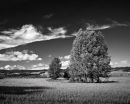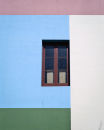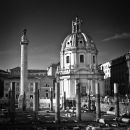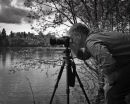Articles
Adobe Lightroom
14/12/2011
In this article I present my thoughts on working with Lightroom in the processing of my photos and how I use it.
August 2009 I bought Adobe Lightroom for the postprocessing of my photos. Until then I used Sigmas own Photo Pro to convert the Raw files and then I did the rest of the work in Adobe Photoshop Elements. Of course the results were not bad with these softwares. But when I participated in a photo workshop in Biarritz, I discovered the possibilities within Lightroom.
Since I installed Lightroom I have not used other software for my work so far. I find it very good for creative working with the photos. To me it was an eye opener to read the book by Rob Sheppard: "Adobe Photoshop Lightroom 2 for Digital Photographers Only"about how to use Lightroom as a photographer. Here he has a very important statement to me: "You see this all the time from photographers who think that they are 'purists' by not adjusting their images, when, in fact, they are 'adjusting' their images by using adjustments set up by engineers in Japan (mostly) who have never seen their subject" (p. 108/109). I think this is a very important question: is the picture as it comes from the camera really the photo I want? As if the makers of the camera has the right taste and thought about my photo. To me Lightroom gives me the control over my work I did not have until then. It has opened a creative power in me I had not known yet. So today I am very grateful to have the program for my work.
I started following the workflow proposed by Sheppard and I use it still use parts of it, because I think it achieves good results. Of course the most important is my view, my vision. Therefore it is important for me to have a good computer that lets me see the changes I do in real time. It is about perception, light, composition … a colorcalibrated photomonitor is of essence for this work. My computer is an Apple Mac Pro, but the monitor is a LaCie 324. I don't like the glare in the Apple monitors, I am always reflected in it. Frankly I do not understand how Apple thinks that their monitors could be used for photographical work.
Lately I have developed my workflow further. With the actual Lightroom 3.6, I do start by removing all initial autimatic settings. Then I always pass trough the lens correction adding some adjustments to the lines or horizon before cropping the image if necessary . Lightroom has indeed a great cropping tool, maybe the best there is. For those who are not keen to crop, I think the words of Andrea G. Stillman in the article "Notes on selected photographs" in "Ansel Adams in the National Parks" are important to note: "Precise cropping was a hallmark of Ansel's photographs … His goal was to remove distractions so that the viewer could focus on the main subject … In Ansel's workroom there was a large paper cutter that he used for cropping … When students came to visit him with their portfolios, Ansel often suggested ways to improve a composition through cropping. He was remarkably consistent in the way he cropped his photographs, and he considered his decisions inviolate. If a publisher imposed its own cropping on one of his photographs for a magazine or book, he would protest vigorously" (p. 304).
Depending on the motive and the expression I choose, I will keep the 2x3 format from the camera or I will crop it to the classical formats of 4x5 or square. The smaller formats often do give a tighter composition. Lightroom has the different sizes predefined, so the crop is easy to make.
Then I turn to the light and colors. If I want a black and white photo I already convert the photo at this point. Black and white is not just a converted color photo, but has its own tonality and light. Therefore I prefer to convert it before working on the light and the grey tones. Anyhow I nearly always start setting the black points and the white points of a photo. This gives a greater dynamic range in the colors or grey tones if done properly.
After that I will go trough the different possibilities in the 'Basic' settings. First I will define the white and the black points with the exposure and black sliders. If the highlights are clipped, I will also use the recovery slider. Some times I add some fill light. Then I add some clarity before I check the 'Tone curve'. Then I will add some vibrancy and maybe some saturation to the colors, before I eventually will add one or more filters and dodge or burn parts of the photo. Further I normally will choose a weak vignette and passing trough the sharping in 'Detail'. If there are any dust spots now the moment has come to remove them.
The last part will be to check the colors or grey tones. Here my personal perception of the scene and the expression I want to transmit will be of great importance. It will give life to the photo or not. When I am satisfied, I will print it to see it how it really is … I always like to have the best photos on print. The print is the end of the process. The print module of Lightroom is very easy to use. The Internet can't really reproduce the photos in the best way, it just serves to give an idea of the photo.
I think one of the great possibilities in digital processing compared to the classical film, is the control I do have now of the whole process from taking the photo to printing it. It is satisfying to see the results of the workflow and enjoy the photo when it is finished.
2nd version, revised and updated 14th of December 2011
Since I installed Lightroom I have not used other software for my work so far. I find it very good for creative working with the photos. To me it was an eye opener to read the book by Rob Sheppard: "Adobe Photoshop Lightroom 2 for Digital Photographers Only"about how to use Lightroom as a photographer. Here he has a very important statement to me: "You see this all the time from photographers who think that they are 'purists' by not adjusting their images, when, in fact, they are 'adjusting' their images by using adjustments set up by engineers in Japan (mostly) who have never seen their subject" (p. 108/109). I think this is a very important question: is the picture as it comes from the camera really the photo I want? As if the makers of the camera has the right taste and thought about my photo. To me Lightroom gives me the control over my work I did not have until then. It has opened a creative power in me I had not known yet. So today I am very grateful to have the program for my work.
I started following the workflow proposed by Sheppard and I use it still use parts of it, because I think it achieves good results. Of course the most important is my view, my vision. Therefore it is important for me to have a good computer that lets me see the changes I do in real time. It is about perception, light, composition … a colorcalibrated photomonitor is of essence for this work. My computer is an Apple Mac Pro, but the monitor is a LaCie 324. I don't like the glare in the Apple monitors, I am always reflected in it. Frankly I do not understand how Apple thinks that their monitors could be used for photographical work.
Lately I have developed my workflow further. With the actual Lightroom 3.6, I do start by removing all initial autimatic settings. Then I always pass trough the lens correction adding some adjustments to the lines or horizon before cropping the image if necessary . Lightroom has indeed a great cropping tool, maybe the best there is. For those who are not keen to crop, I think the words of Andrea G. Stillman in the article "Notes on selected photographs" in "Ansel Adams in the National Parks" are important to note: "Precise cropping was a hallmark of Ansel's photographs … His goal was to remove distractions so that the viewer could focus on the main subject … In Ansel's workroom there was a large paper cutter that he used for cropping … When students came to visit him with their portfolios, Ansel often suggested ways to improve a composition through cropping. He was remarkably consistent in the way he cropped his photographs, and he considered his decisions inviolate. If a publisher imposed its own cropping on one of his photographs for a magazine or book, he would protest vigorously" (p. 304).
Depending on the motive and the expression I choose, I will keep the 2x3 format from the camera or I will crop it to the classical formats of 4x5 or square. The smaller formats often do give a tighter composition. Lightroom has the different sizes predefined, so the crop is easy to make.
Then I turn to the light and colors. If I want a black and white photo I already convert the photo at this point. Black and white is not just a converted color photo, but has its own tonality and light. Therefore I prefer to convert it before working on the light and the grey tones. Anyhow I nearly always start setting the black points and the white points of a photo. This gives a greater dynamic range in the colors or grey tones if done properly.
After that I will go trough the different possibilities in the 'Basic' settings. First I will define the white and the black points with the exposure and black sliders. If the highlights are clipped, I will also use the recovery slider. Some times I add some fill light. Then I add some clarity before I check the 'Tone curve'. Then I will add some vibrancy and maybe some saturation to the colors, before I eventually will add one or more filters and dodge or burn parts of the photo. Further I normally will choose a weak vignette and passing trough the sharping in 'Detail'. If there are any dust spots now the moment has come to remove them.
The last part will be to check the colors or grey tones. Here my personal perception of the scene and the expression I want to transmit will be of great importance. It will give life to the photo or not. When I am satisfied, I will print it to see it how it really is … I always like to have the best photos on print. The print is the end of the process. The print module of Lightroom is very easy to use. The Internet can't really reproduce the photos in the best way, it just serves to give an idea of the photo.
I think one of the great possibilities in digital processing compared to the classical film, is the control I do have now of the whole process from taking the photo to printing it. It is satisfying to see the results of the workflow and enjoy the photo when it is finished.
2nd version, revised and updated 14th of December 2011










